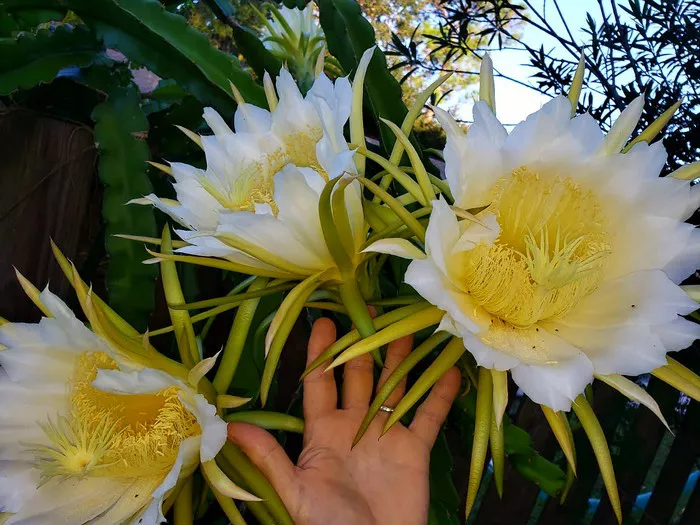Dragon fruit, also known as pitaya, is a visually stunning and nutritionally rich fruit that has gained popularity in recent years due to its exotic appearance and health benefits. However, for many dragon fruit growers, the sight of beautiful flowers on their plants may be followed by disappointment when those flowers fail to produce fruit. This phenomenon can be frustrating and puzzling, leading growers to wonder why their dragon fruit plants are flowering but not yielding fruit.
Understanding Dragon Fruit Reproduction
To comprehend why dragon fruit plants may not be bearing fruit despite flowering, it’s crucial to understand the reproductive biology of these plants. Dragon fruit plants belong to the genus Hylocereus and are typically propagated through stem cuttings rather than seeds. The flowers of dragon fruit plants are large, nocturnal, and typically self-pollinating, although they can also be cross-pollinated by insects such as bees and moths.
The flowering and fruiting process of dragon fruit plants can be influenced by various factors, including environmental conditions, pollination, plant age, and cultural practices. Understanding these factors is essential for troubleshooting why a dragon fruit plant may produce flowers but fail to set fruit.
Environmental Factors
Environmental conditions play a significant role in the flowering and fruiting of dragon fruit plants. Optimal conditions for fruit set include:
1. Temperature: Dragon fruit plants thrive in warm climates and require temperatures between 65°F to 95°F (18°C to 35°C) for optimal growth and fruit production. Extreme temperatures outside this range can hinder flower development and fruit set.
2. Light: Dragon fruit plants require ample sunlight to flower and produce fruit. Insufficient light or irregular light exposure can disrupt the flowering process and reduce fruit yield.
3. Watering: Proper irrigation is crucial for the healthy growth and development of dragon fruit plants. Inadequate watering can lead to flower drop and poor fruit set, while excessive watering can cause root rot and other issues that affect plant health.
4. Soil Conditions: Dragon fruit plants prefer well-draining soil with a slightly acidic to neutral pH. Poor soil drainage or soil compaction can impede root development and limit nutrient uptake, affecting flower and fruit production.
Pollination
While dragon fruit flowers are primarily self-pollinating, they can benefit from cross-pollination by insects such as bees and moths. Adequate pollination increases the likelihood of fruit set and can improve fruit quality and yield. Factors that may affect pollination include:
1. Pollinator Availability: The presence of pollinators in the growing area can significantly impact fruit set in dragon fruit plants. Lack of pollinators due to habitat loss or pesticide use can reduce pollination rates and result in poor fruit yield.
2. Flower Synchronization: Dragon fruit flowers typically open at night and remain open for only one night, making timing crucial for effective pollination. Ensuring that flowers are open and receptive when pollinators are active can increase the chances of successful pollination and fruit set.
3. Pollination Efficiency: In some cases, self-pollination may not be as efficient as cross-pollination in dragon fruit plants. Introducing pollinators or hand-pollinating flowers can improve fruit set and yield, especially in environments with limited pollinator activity.
Plant Age and Health
The age and health of a dragon fruit plant can also influence its flowering and fruiting behavior. Factors to consider include:
1. Maturity: Dragon fruit plants typically begin flowering and fruiting when they reach maturity, which can take anywhere from six months to several years, depending on the variety and growing conditions. Young plants may produce flowers but fail to set fruit until they reach maturity.
2. Nutritional Status: Proper nutrition is essential for the growth and development of dragon fruit plants. Nutrient deficiencies or imbalances can impair flower formation and fruit set, leading to poor yields. Regular soil testing and fertilization can help maintain optimal nutrient levels for plant growth and reproduction.
3. Pest and Disease Management: Pests and diseases can negatively impact the health and productivity of dragon fruit plants. Common pests include scale insects, mealybugs, and spider mites, while diseases such as fungal infections can affect flower development and fruit set. Implementing integrated pest management strategies and maintaining good plant hygiene can help prevent pest and disease outbreaks.
Cultural Practices
Cultural practices such as pruning, trellising, and fertilization can affect the flowering and fruiting of dragon fruit plants. Considerations include:
1. Pruning: Proper pruning can promote airflow and light penetration within the plant canopy, which can improve flower development and fruit set. Removing dead or diseased branches and limiting excessive vegetative growth can encourage the plant to allocate resources towards flowering and fruit production.
2. Trellising: Providing support for dragon fruit plants through trellising or staking can help prevent damage to flowers and fruit from contact with the ground. Additionally, trellising can promote upward growth and better exposure to sunlight, leading to improved flowering and fruiting.
3. Fertilization: Applying balanced fertilizer formulations containing essential nutrients such as nitrogen, phosphorus, and potassium can support healthy growth and flowering in dragon fruit plants. However, excessive fertilizer application can lead to nutrient imbalances and adverse effects on flower and fruit development. It’s essential to follow recommended fertilizer rates and schedules based on soil testing and plant nutrient requirements.
Conclusion
While the sight of flowering dragon fruit plants is undoubtedly beautiful, the absence of fruit can be disappointing for growers. By understanding the factors influencing flower and fruit production in dragon fruit plants, growers can take proactive measures to optimize growing conditions, promote pollination, and enhance plant health and productivity. Through careful attention to environmental conditions, pollination, plant age and health, and cultural practices, growers can maximize fruit yield and enjoy the flavorful and nutritious bounty of their dragon fruit harvests.


